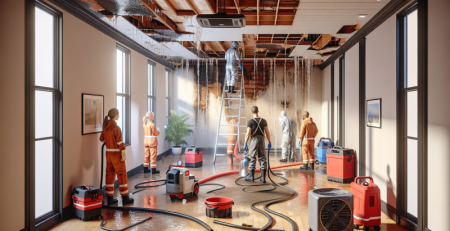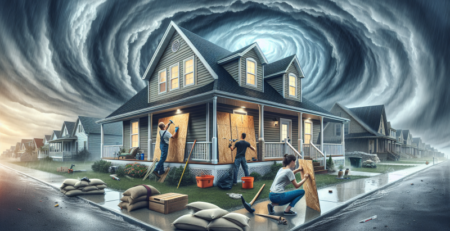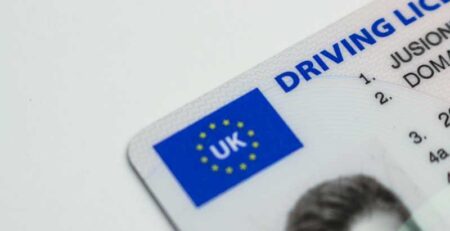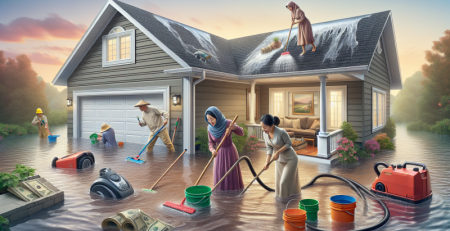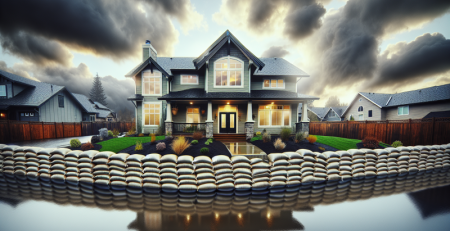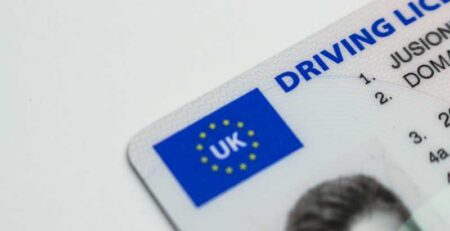Understanding the Risks of DIY Mold Removal
When it comes to dealing with mold in your home, the allure of DIY mold removal can be tempting. However, understanding the risks of DIY mold removal is crucial for homeowners and property managers alike. While tackling mold on your own may seem like a cost-effective solution, it can often lead to more significant problems if not done correctly. Mold can pose serious health risks, and improper removal techniques can exacerbate the issue, spreading spores throughout your living space. At Kraus Restoration, NJ’s leaders in water damage restoration, we emphasize the importance of professional mold cleanup. Our IICRC certified experts are trained to handle mold damage safely and effectively, ensuring thorough remediation and preventing future growth. With our 24/7 emergency services, we are here to help you restore your home and peace of mind. In this blog, we will explore the potential dangers of DIY mold removal and why enlisting the help of professionals is the best course of action for your property.
Common Hazards Associated with DIY Mold Removal
When it comes to tackling mold in your home, the allure of DIY mold removal can be strong. Many homeowners believe that they can save money and time by handling the problem themselves. However, this approach can lead to a range of hazards that may not only exacerbate the mold issue but also pose serious health risks. Understanding these hazards is crucial for anyone considering a DIY mold removal project.
One of the primary risks associated with DIY mold removal is exposure to mold spores. Mold can release spores into the air, which can be inhaled or come into contact with skin. According to the Centers for Disease Control and Prevention (CDC), exposure to mold can lead to a variety of health issues, particularly for individuals with respiratory conditions, allergies, or weakened immune systems. Symptoms can range from mild irritation to severe respiratory distress. In fact, the CDC notes that "some people are sensitive to mold, and exposure can cause a range of health effects, including nasal congestion, throat irritation, coughing, and eye irritation."
Another significant hazard is the potential for improper removal techniques. Many DIY enthusiasts may not be aware of the correct methods for safely removing mold. Using inadequate cleaning solutions or failing to contain the mold spores during the removal process can lead to cross-contamination, spreading the mold to other areas of the home. The Environmental Protection Agency (EPA) emphasizes the importance of containment, stating that "if you can see or smell mold, you need to take steps to clean it up." Without proper containment measures, mold can easily migrate to unaffected areas, creating a larger problem that may require professional intervention.
In addition to health risks and improper techniques, DIY mold removal can also lead to structural damage. Mold thrives in damp environments, and if not addressed correctly, it can penetrate walls, ceilings, and other structural components of a home. This can result in costly repairs that far exceed the initial savings of a DIY approach. The National Institute of Health (NIH) reports that "mold can weaken the structural integrity of buildings, leading to significant repair costs." Homeowners may find themselves facing extensive renovations if mold is not effectively removed.
Furthermore, there is the risk of using hazardous materials during the removal process. Many common mold removal products contain harsh chemicals that can be harmful if not used properly. Inhaling fumes or coming into contact with skin can lead to chemical burns or respiratory issues. The CDC advises that "when using cleaning products, ensure proper ventilation and wear protective gear." However, many DIYers may overlook these safety precautions, putting themselves at risk.
Another overlooked hazard is the psychological impact of mold exposure. Living in a mold-infested environment can lead to stress and anxiety, particularly for individuals with pre-existing health conditions. The presence of mold can create a sense of unease in the home, affecting overall well-being. According to a study published in the Journal of Environmental Health, "mold exposure has been linked to increased stress levels and decreased quality of life." This psychological toll can be just as significant as the physical health risks associated with mold.
In summary, while the idea of DIY mold removal may seem appealing, the associated hazards can be significant. From health risks due to mold exposure to the potential for structural damage and the use of hazardous materials, the dangers are numerous. Homeowners are encouraged to consider the implications of their actions carefully. For those who suspect a mold problem in their home, seeking professional assistance may be the safest and most effective solution. Professionals have the training and equipment necessary to handle mold safely and effectively, ensuring that the problem is resolved without risking health or property.
For more information on mold cleanup and the importance of professional services, visit our mold cleanup page. If you have questions or need assistance, feel free to contact us. Understanding the risks associated with DIY mold removal is the first step in protecting your health and home.
References:
- Centers for Disease Control and Prevention. “Mold.” CDC Mold Information.
- Environmental Protection Agency. “Mold Remediation in Schools and Commercial Buildings.” EPA Mold Remediation Guide.
- National Institute of Health. “Mold and Health.” NIH Mold Health Effects.
- Journal of Environmental Health. “Mold Exposure and Quality of Life.” JEH Study on Mold.
When to Seek Professional Help for Mold Issues
Mold can be a persistent and troublesome issue in homes and buildings, often leading to health risks and structural damage if not addressed promptly and effectively. While many homeowners may consider tackling mold removal on their own, there are specific circumstances when seeking professional help is not just advisable but necessary. Understanding when to call in the experts can save you time, money, and potential health hazards.
One of the primary indicators that you should seek professional help for mold issues is the extent of the infestation. If you discover mold growth that covers an area larger than 10 square feet, it is generally recommended to consult with professionals. Large infestations can indicate underlying problems, such as significant water damage or poor ventilation, which require specialized knowledge and equipment to address effectively. Professionals have the training to assess the situation accurately and implement a comprehensive remediation plan.
Another critical factor to consider is the type of mold present. While many molds are harmless, some can produce mycotoxins that pose serious health risks. If you suspect that the mold in your home is toxic or if you have visible signs of black mold, it is crucial to contact a mold remediation expert. They can conduct tests to identify the type of mold and determine the best course of action for safe removal. Attempting to remove toxic mold without proper training and equipment can lead to further contamination and health issues.
Health concerns are also a significant reason to seek professional help. Individuals with respiratory issues, allergies, or weakened immune systems are particularly vulnerable to mold exposure. If anyone in your household experiences persistent health problems that you suspect may be related to mold, it is essential to consult with a professional. They can assess the situation and provide solutions that prioritize the health and safety of your family. Additionally, if you or anyone in your household experiences severe reactions, such as difficulty breathing or allergic reactions, it is vital to seek medical attention and professional mold remediation immediately.
If you have already attempted DIY mold removal and the problem persists, it is a clear sign that professional intervention is needed. DIY methods may not effectively eliminate the mold or address the root cause of the moisture problem, leading to recurring issues. Professionals have access to advanced tools and techniques that can ensure thorough removal and help prevent future growth. They can also identify and repair any underlying issues, such as leaks or inadequate ventilation, that may have contributed to the mold problem in the first place.
Another important consideration is the potential for structural damage. Mold can weaken the integrity of building materials, leading to costly repairs if not addressed promptly. If you notice signs of damage, such as warped walls, ceilings, or floors, it is crucial to seek professional help. Experts can assess the extent of the damage and recommend appropriate remediation strategies to restore your home safely.
In some cases, mold issues may arise in areas that are difficult to access, such as behind walls, under floors, or in HVAC systems. These hidden mold infestations can be particularly challenging to address without professional assistance. Experts have the tools and experience to locate and remediate mold in hard-to-reach areas, ensuring that your home is thoroughly cleaned and safe.
Finally, if you are unsure about the extent of the mold problem or how to handle it, it is always better to err on the side of caution and consult with a professional. They can provide a thorough inspection and offer guidance on the best steps to take. Professional mold remediation services not only remove the mold but also provide valuable advice on preventing future growth, ensuring that your home remains safe and healthy.
In conclusion, while DIY mold removal may seem like a cost-effective solution, there are numerous situations where seeking professional help is the best course of action. From large infestations and toxic mold to health concerns and structural damage, the risks associated with mold can be significant. If you find yourself facing any of these issues, do not hesitate to reach out to experts who can provide the necessary support and expertise. For more information on mold cleanup and restoration services, visit mold cleanup or contact us for assistance. Your health and safety should always come first when dealing with mold issues.
In conclusion, while the allure of DIY mold removal can be tempting for homeowners looking to save time and money, it is crucial to fully understand the potential risks involved. Mold can pose serious health hazards, and improper removal techniques may exacerbate the problem, leading to further contamination and costly repairs. Additionally, without the right protective gear and knowledge of mold types, DIY efforts can put individuals at risk of exposure to harmful spores. For those facing significant mold issues, it is often wiser to consult with professionals who have the expertise and equipment to handle the situation safely and effectively. Ultimately, prioritizing health and safety should always come first, and understanding the complexities of mold removal is essential in making informed decisions for your home.

